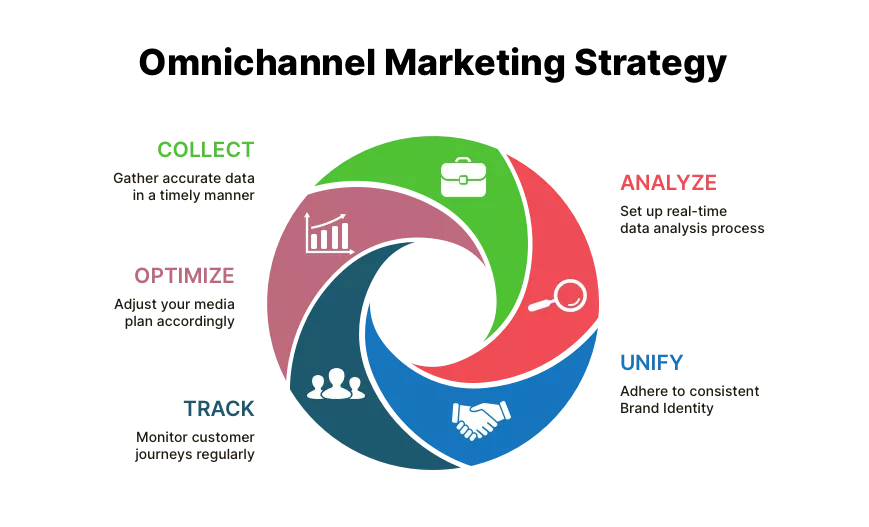Omnichannel marketing is a strategy employed by many large organizations around the world, although it is not a term you may frequently encounter. Think of it as a way of surrounding your potential customers with easy, seamless ways to interact with your brand. Let’s take a deep dive!
Understanding Omnichannel Marketing
The Word “Omnichannel”: Where It Comes From
- Omni: Means “all” or “every” and comes directly from Latin.
- Channel: Stems from the Latin word “canalis”, meaning “groove, channel, waterpipe”. It refers to a path of communication or a medium for interaction.
Omnichannel marketing is all about connecting the dots between the various ways people find your company or brand. This includes:
- Offline Channels: Your brick-and-mortar stores and delivery methods.
- Online Channels: Websites, emails, social media, ads, you name it!
The goal is a smooth, satisfying experience for the customer no matter how they interact with you – being able to seamlessly switch between channels. An example of this would be a customer placing an order online for pickup in person – if a company’s omnichannel strategies are solid, this ought to be a straightforward and seamless experience for the customer.
Omnichannel marketing is becoming more and more commonplace and is no longer limited to retail. Such diverse industries as healthcare, finance, and tech are all making use of it.
So, let’s explore how it works and how you can make it work for you.
Key Elements of Omnichannel Marketing
Think of omnichannel marketing as a customer-first strategy. Modern consumers have endless options when it comes to interacting with their favorite brands. They have a wealth of alternate brands if they’re not happy with their current product or service.
This means you need:
- Strong Brand Identity: People should instantly recognize you (think Nike’s swoosh or the McDonald’s arches).
- Personalized Experiences: Tailor content and offers based on customer interests and where they are in their buyer journey.
- Consistency: Your message and how you treat customers should feel the same across every touchpoint.
The Benefits of Omnichannel
Yes, omnichannel marketing can be complex, but the rewards are huge!
Here’s why it’s worth the effort:
- Stand Out From the Crowd: A unified brand experience across channels builds major recognition. Rather than micromanaging individual channels – a company can ensure a cohesive brand image.
- Happy, Loyal Customers: With the customer-first approach, when people feel known and understood, they stick around!
- Boost Profits: Omnichannel customers are way more valuable, spending more over time, and come back often. Some sources estimate that omnichannel customers are 30% more valuable. What’s more, it leads to increased customer loyalty – repeat customers can account for up to 40% of a business’s revenue.
- Better Data: You’ll learn tons about your customers, helping you target your efforts to perfection. Because the customer is engaged across multiple channels, it builds a more cohesive customer profile, which can be used to fine-tune a company’s marketing KPIs.
How to Make the Most of Omnichannel Marketing
It’s time for a mindset shift to focus fully on the customer (rather than the channel).
Here are the key steps:

- Gather the Right Data: Knowing how, when, and on what devices customers reach you is essential for personalization.
- What sort of advertising will they respond to? Are they more likely to interact with your brand on a mobile device or personal computer? What good or service are they looking for?
- Need help tracking all that? Unified Marketing Measurement (UMM) tools are invaluable.
This attribution model combines two key components of marketing analysis (Marketing Mix Modeling and Multi-Touch Attribution) to bring you the best of both worlds, allowing you to obtain feedback on the micro (customer) and macro (aggregate) measurements simultaneously.
- Analyze Data Quickly: You need to be able to make changes based on what the data is telling you.
- This means a dedicated analysis team that can act on data in real time to right the ship or steer it in a new direction.
- This means a dedicated analysis team that can act on data in real time to right the ship or steer it in a new direction.
- Consistent Branding: It’s important that all departments and channels are on the same page when it comes to brand identity.
- Work with your teams to create clear brand guidelines that everyone follows.
- Work with your teams to create clear brand guidelines that everyone follows.
- Track Customer Journeys: Mapping out how people move from first contact to purchase is a goldmine for targeting your efforts.
- Such maps facilitate customer targeting based on personal interests, the user interface/experience, and exogenous economic factors (economic downturns, recessions or booms, for instance).
- Such maps facilitate customer targeting based on personal interests, the user interface/experience, and exogenous economic factors (economic downturns, recessions or booms, for instance).
- Always Optimize: Omnichannel is an ongoing process. Experiment, learn, and adapt constantly.
- Media planning tools and dedicated teams should be employed to constantly assess the efficacy of current omnichannel marketing, as well as deploy hypothetical scenarios that can account for target audience, marketing budget, media mix, and multiple KPIs.
- Media planning tools and dedicated teams should be employed to constantly assess the efficacy of current omnichannel marketing, as well as deploy hypothetical scenarios that can account for target audience, marketing budget, media mix, and multiple KPIs.
Omnichannel Marketing Examples
Let’s take a look at some companies that have already been making the best use of an omnichannel approach.
Nordstrom
Clothing giant Nordstrom seamlessly blends online and in-store experiences, like their partnership with Pinterest for in-store upsells. Smart and successful!
Shoppers in brick-and-mortar Nordstrom stores can scan a Pincode, which takes the user to a Pinterest page with Nordstrom bargains. In addition to being a novel wrinkle in the offline shopping experience, the feature has driven sales via word-of-mouth and subtle suggestive upselling.
The brand has turned its hand to YouTube videos that offer solid, constructive advice and conclude with a perfectly pitched call to action. Other companies would do well to learn from this unique and multifaceted marketing strategy.
Timberland
Similar to Nordstrom, Timberland is integrating its on- and offline experiences by having customers make use of apps in-store to drive customer engagement. The in-store ‘Touchwalls’, flashing up personalized information regarding various kinds of shoes and sneakers.
Customers can use these walls to add footwear to their wishlist or cart, and can then purchase the footwear in-store if they wish. Timberland is also able to use the data collected to recommend more obscure makes of footwear, which leads to an increase in sales for their lesser-purchased stock.
Starbucks
As many focus on the apps, Starbucks wins by making it super easy to top up your rewards card from your computer or device and skip the morning lines by ordering via the app. Consumer convenience is prioritized.
Amazon
They excel at personalization and convenience across every channel imaginable. That focus on the customer is why they’re on top. Amazon’s answer to omnichannel marketing is blinding in both its simplicity and its brilliance: Amazon Prime.
There are tons of reasons why customers sign up for Amazon Prime, making it a great example of the omnichannel approach. Initially, Prime was like a ‘discount card’ for fast, free shipping – a huge reason people subscribe. Amazon often offers trial memberships to hook new customers, and the convenience quickly outweighs the monthly cost.
But to keep people hooked even further, Amazon keeps adding benefits. Here are a few of the biggest draws:
- Prime Wardrobe: Virtually try on clothes before you buy them.
- Streaming Discounts: Get cheaper subscriptions to services like HBO Go, plus grocery deals.
- Unlimited Video & Music: Access Amazon’s massive streaming library.
Why does Amazon offer so much? Simple: it gathers all your data in one place. This fuels their powerful recommendation engine and makes Prime Video just as easy to use as Prime Delivery. In short, they’ve created a seamless experience across channels that keeps customers spending and coming back for more.
Walgreens
The drugstore giant Walgreens has its own app that makes refilling prescriptions super easy. But they didn’t stop there! They added health-tracking features (like those on your Fitbit or Apple Watch) to boost engagement with promotions, contests, and leaderboards. This clever mix of pharmacy and health app features increases brand awareness in a way that feels helpful, not pushy – a great way to boost customer loyalty and sales.
Trends to Watch in Omnichannel Marketing
Omnichannel is the future of marketing, and these trends are already shaping how successful businesses operate. If you want to maximize your ROI, pay attention to:
1. Blending Online and In-Store Experiences
Brands like Starbucks, Nordstrom, and Timberland prove there’s no longer a purely offline experience. Customers want the convenience of ordering online and picking up in-store. Make this process easy, and they’ll choose your business.
2. It’s About the Brand, Not Just the Channel
As Amazon shows, brand consistency is key. Customers want the same great experience whether they’re on your app, website, or in your store. Provide that, and you’ll win.
3. More Channels = More Profit
Plain and simple, customers who engage with you on multiple channels spend 3-4 times more than those on a single channel. Give them options!
4. Rise of Multi-Device Purchases
You think someone buys some things on their phone and others on their TV? Think again!
They may start a purchase on their phone and finish on another device. Important points:
- Make it easy to switch devices seamlessly (think shopping carts that sync across platforms).
- This lets you track customers across devices, leading to better data = better marketing!
Omnichannel = The Future!
This is how modern companies win. Meet customers where they are, on their terms. Make it easy to interact, and build that recognizable, consistent brand. Do this right, and you’ll see greater loyalty, sales, and long-term success.




